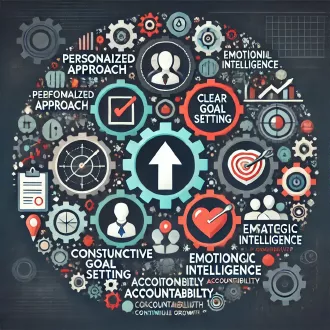Transcription Stages of team development
The success of any work team is influenced by the stages of development it goes through, at this point we will explore the "Forming, Storming, Norming, Performing" model proposed by Bruce W. Tuckman.
These stages, ranging from the initial formation of the team to its functioning at its full potential, are essential to understanding how a group of individuals can be transformed into a cohesive and highly productive team. Leadership coaching is an effective way to guide teams through these stages, thus facilitating their path to optimal performance.
In today's dynamic, where companies face increasing expectations to achieve significant results with limited resources, building and sustaining high-performance teams takes on significant importance. Business researchers have demonstrated a long-standing interest in discovering how to build teams that are capable of generating results that transcend the individual contributions of their members.
Accumulated knowledge has revealed that as differences among team members intensify, so do the opportunities for success. However, this increase in diversity can also be accompanied by an increase in disagreements and infighting. However, the formation of highly effective teams is not an instantaneous process; it takes time for a new team to cohere and reach its full capacity. In this transformation process, team members go through various stages as they evolve from strangers to each other to interdependent colleagues and collaborators.
The approach provided by Tuckman's model, which encompasses the stages of forming, storming, norming and executing, provides a valuable structure that leaders and coaches can use to understand and facilitate team development. At each of these stages, specific strategies can be implemented to foster team progress and cohesion.
The stages and their impact on performance are explored here:
- Forming: In this initial stage, team members meet and get to know each other. Roles and responsibilities may be unclear, which can lead to uncertainty. But generally members remain enthusiastic and willing to socialize.
Leadership at this stage is crucial for:
- Facilitating the introduction of team members.
- Providing clear guidance.
- Establishing direction, objectives and expectations.
- Providing a welcoming environment to foster collaboration.
Performance can be poor at this stage due to lack of clarity and structure.
- Storming: In this stage, conflicts and tensions may arise as team members get to know each other better and compete for positions and roles.
Leadership at this stage is crucial to:
- Overcoming resistance from team members.
- Encourage open communication.
- Facilitate conflict resolution.
- Build stronger relationships.
Performance can be inconsistent due to conflict and lack of cooperation.
- Norming: At this stage, teams begin to establish norms and operating rules. Roles and responsibilities become clearer and a sense of cohesion develops. At this point, the leader or coach can recognize and reward both individual efforts and the achievements of the team as a whole.
Leadership at this stage is crucial to:
- Establishing a clear purpose.
- Foster collaboration and commitment, ensuring that the team is aligned on its shared goals.
- Provide learning opportunities.
- Provide constant feedback.
Performance improves as clear rules and roles are established. Their involvement increases and they support each other.
- Performing: At this stage, the team operates efficiently and cohesively. Roles are well defined, communication is fluid and the focus is on achieving objectives. The leader or coach assumes a more supportive role as the team functions without constant intervention and is able to self-regulate.
Leadership at this stage is crucial for:
- Individual empowerment and development, using coaching to maximize the potential of each team member.
- Celebration of achievement.
- Promoting decision making.
- Collective problem solving within the team.
Performance is optimal at this stage, productivity increases and performance soars.
team work




